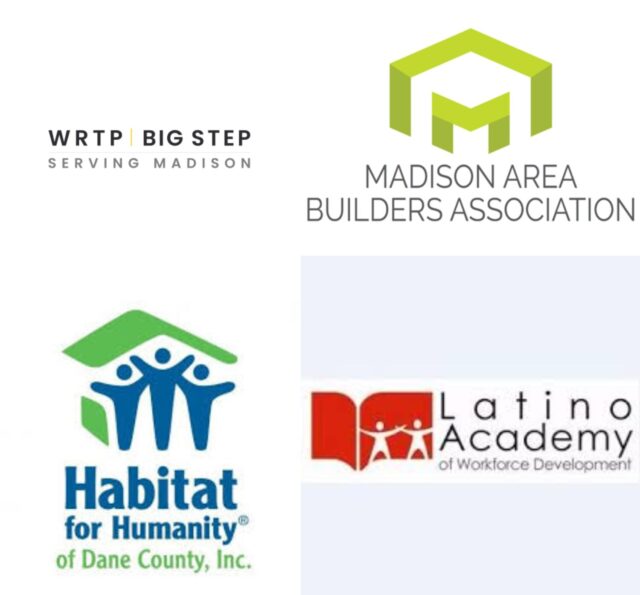Special promotional content provided by the Boys and Girls Clubs of Dane County
The McKenzie Regional Workforce Center is a collaborative effort to connect young people in the Madison area with careers in the trades, as well as financial literacy, entrepreneurship training and many other career-focused resources. While it’s led by the Boys and Girls Club of Dane County (BGCDC), it couldn’t exist without true and deep commitment from a range of community partners. The primary partners are detailed below.
 Madison Area Builders Association
Madison Area Builders Association
For more than 75 years, the Madison Area Builders Association (MABA) has represented the construction industry in south central Wisconsin and connected contractors with home buyers and commercial clients. An affiliate of the Wisconsin Builders Association and the National Association of Home Builders, MABA represents more than 100 builder members and 300 associate members. As a core partner of the Boys and Girls Club of Dane County and the McKenzie Regional Workforce Center, MABA has developed some of the programming and curriculum and recruited volunteers to introduce young people to the trades.
“Our major initiative in this Boys and Girls Club project is just getting more youth interested in the trades,” says MABA CEO Chad Lawler. He notes a significant issue in the building trades is its aging workforce – a workforce that’s not diverse enough to survive.
“We’re filling the pipeline, so that 10 years from now, we’re not saying the same exact thing we’ve been saying,” he says. “We want the industry to look like Madison. We can be intentional in who we’re looking for in our workforce. Let’s change some lives and focus on individuals from less affluent neighborhoods and backgrounds.”
 Habitat for Humanity of Dane County
Habitat for Humanity of Dane County
“We don’t build houses, we build homes, community and hope.”
So says recently retired Habitat for Humanity of Dane County CEO Valerie Renk. The local affiliate of the national organization has built 300 homes for low-income families since its establishment in 1984. Renk said Habitat of Dane County is thrilled to support the BGCDC and the MWRC in offering hands-on experience in homebuilding for youth.
“What’s different about this project is getting to build a future workforce, which helps habitat it helps all builders. It also helps us build strong families,” she says. “We get them out on a real work site, and they get to really build out a house. We want those kids to be motivated, and aspirational.”
Renk says the goal to diversify the trades workforce is admirable, because it also reflects the clients.
“Sixty percent of the families we serve are people of color,” Renk says. “One of the goals of the MRWC is to get more diversity in those trades. I would love to see these kids get really good paying jobs, and when they retire, they can be volunteers helping other people. That, to me, would be the most amazing success ever.”
 WRTP | BIG STEP
WRTP | BIG STEP
“Our job is to connect the community to careers in construction and manufacturing through the apprenticeship model,” says Toni White, chief operating officer of Wisconsin Regional Training Partnership, a nonprofit workforce intermediary founded in the early 1990s to respond to workforce challenges. WRTP is partnered with Building Industry Group Skilled Trade Employment Program (BIG STEP), which was created in the 1970s to increase the number of women, minorities, and younger workers employed in the building trades. WRTP specializes in the development of hands-on, group-size pre-employment training certificate programs, while BIG STEP focuses on individualized tutoring in academic skills for apprenticeship exams.
WRTP and BIG STEP are helping BGCDC to create curriculum and apprenticeship programs for their young program participants.
“They’re starting to move into that youth apprenticeship space,” White says. “It’s about how to make that career pathway streamline amongst partners. It allows the students and the employers to connect, and they learn more about each other in that process.”
WRTP typically works with adults after they’ve graduate high school or technical college, so working with BGCDC youth is an exciting new challenge.
“It’s a new thing to go down into the school systems all the way to middle school, and start programming and creating ideas with Boys and Girls Club on how to get students thinking about careers in the trades,” White says. “We found that the earlier young people are exposed, the more likely they are to continue in that career pathway, especially when you make it accessible.”
 Latino Academy of Workforce Development
Latino Academy of Workforce Development
Launched in 2013 as a program of the Vera Court Neighborhood Center, the Latino Academy of Workforce Development became its own independent nonprofit organization and moved into its own new headquarters in Madison last year. Over the years it’s helped thousands of people earn their GED, commercial driver license (CDL), and other certifications, as well as learning English.
For the BGCDC, the Latino Academy are using their CDL training to introduce young people to careers in transportation, as well as leading workplace safety trainings such as OSHA compliance, fall prevention and CPR.
“We’re very, very excited that they brought us in, for us to be able to bring that culturally diverse perspective when working with our Latinx community,” says Latino Academy founder and executive director Baltazar de Anda Santana. “There are many youths for whom English is their second language, so the Latino Academy involvement is very important.”
De Anda Santana also wants to help youth, especially Latino youth, see the trades as a valuable and valued career.
“We need to make sure that people don’t see construction as the job of the poor,” he says. “We’ll always try to see where there is a need and the opportunity to collaborate, especially in the workforce.”





























